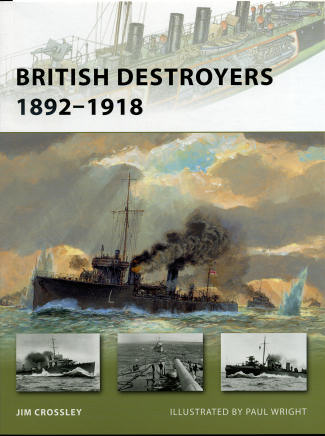 The
latest and greatest in terms of nautical weaponry in the late 1800s was the
torpedo boat. These very small and fast boats were armed with the latest
anti-ship weapon, the torpedo. As they were inexpensive to build and had the
power to sink the largest ship, nations built a considerable number of the
small, fast boats. Of course, one needed a counter to them so the torpedo boat
destroyer was developed. These were larger boats, but just as fast and were also
armed with torpedoes as well as with deck guns.
The
latest and greatest in terms of nautical weaponry in the late 1800s was the
torpedo boat. These very small and fast boats were armed with the latest
anti-ship weapon, the torpedo. As they were inexpensive to build and had the
power to sink the largest ship, nations built a considerable number of the
small, fast boats. Of course, one needed a counter to them so the torpedo boat
destroyer was developed. These were larger boats, but just as fast and were also
armed with torpedoes as well as with deck guns.
These boats were in the 400 ton range and
though promising they were not great sea-keepers, being fast only in calm waters
and not having a lot of range. However, they were determined to be effective and
so were also built in fairly large numbers. It became cumbersome to call them
torpedo boat destroyers so the term was shortened to destroyers and a class of
ship was born.
This book concentrates on those
destroyers built by the British from its inception in 1892 until the end of WWI
in 1918. As the design matured, they quickly went from being boats to actual
ships with proper sea handling and reasonable crew comforts. They also switched
their task from just taking out after enemy torpedo boats to being used with the
fleet at scouts or as vessels used to attack the larger fleet units of the foe.
In this latest book in the New Vanguard
series, the author takes a look at the many different classes of the destroyer
starting with the earliest classes and continuing up until the end of WWI. This
also includes a look at the larger flotilla leader type of boats which were
designed to house the flotilla commander and his staff.
It also looks at how these ships
performed in combat with some of the major engagements of WWI covered from the
point of view of the destroyers. In each of the class listings, it is noted
which of the ships were lost during various engagements and due to enemy action.
It really is an excellent book on a most interesting
subject and one that I am positive you will find to be of interest. One that
will be pulled from the shelves time after time and one I can highly recommend
to you.
October 2009
For more on the complete line of Osprey books,
visit www.ospreypublishing.com. In the US, it is
Osprey Direct at 44-02 23rd St, Suite 219, Long Island City, NY 11101., where you can
get a catalogue of available books.
If you would like your product reviewed fairly and quickly, please contact
me or see other details in the Note to
Contributors.
 The
latest and greatest in terms of nautical weaponry in the late 1800s was the
torpedo boat. These very small and fast boats were armed with the latest
anti-ship weapon, the torpedo. As they were inexpensive to build and had the
power to sink the largest ship, nations built a considerable number of the
small, fast boats. Of course, one needed a counter to them so the torpedo boat
destroyer was developed. These were larger boats, but just as fast and were also
armed with torpedoes as well as with deck guns.
The
latest and greatest in terms of nautical weaponry in the late 1800s was the
torpedo boat. These very small and fast boats were armed with the latest
anti-ship weapon, the torpedo. As they were inexpensive to build and had the
power to sink the largest ship, nations built a considerable number of the
small, fast boats. Of course, one needed a counter to them so the torpedo boat
destroyer was developed. These were larger boats, but just as fast and were also
armed with torpedoes as well as with deck guns.